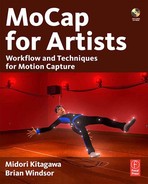Introduction
If anyone asks us “Do you think motion capture will replace key-frame animation?” we will say “No.”
Motion capture (mocap) is a very fast and accurate way to bring human motion into a 3D computer animation, but it is not always the best way. Mocap technology exhibits its remarkable strengths for some projects while other methods, such as key-framing, work much better for some other projects. We all need to make sure that whichever the method we decide to use, that’s the most effective method for the project.
In this book, we try to give you a basic overview of motion capture based off of the most popular method which is currently (circa 2007) optical motion capture that tracks retro-reflective markers. We don’t even try to say that our way is the only way or always the best way, just that it works for us. You will find many different ways to tackle problems as you go along and find different ways to think about mocap data. Every person we know in the mocap industry has a different idea about how to do things and very good reasons for doing them that way. It’s a big pond and there’s room for lots of different ideas and methods. If you use motion capture you’ll create some of your own methods.
Our goal is to help those who are involved in 3D computer animation and games have a better understanding of motion capture as a whole so that they can decide if they need it for a project, and if they do, how it can be used. One of the things we try to do in this book is to have a mix of showing you how to do things and telling you the theory behind it. Neither one of us was interested in writing a “manual” nor a definite guide that tells you exactly what you need to do with specific mocap hardware and software. We wanted to make the information as broad as possible and applicable to as many situations as possible. So there will be times you need to rely on the user manuals from your hardware and software providers.
We are currently using optical motion capture systems at our workplaces and our pipelines involve Maya and MotionBuilder, where MotionBuilder is currently the only widely available motion editing tool with adequate functionality. Many examples in this book are products of the pipelines. However, let us emphasize this again: this is not the only way. Other applications can work in your pipeline.
Photography did not replace painting as some predicted. It has found its own place in visual arts. We believe that motion capture is finding its own place in motion picture and interactive arts.
We hope this book will help you get started with mocap and give you a roadmap to how it all works. We also hope to see results of your creative endeavors.
